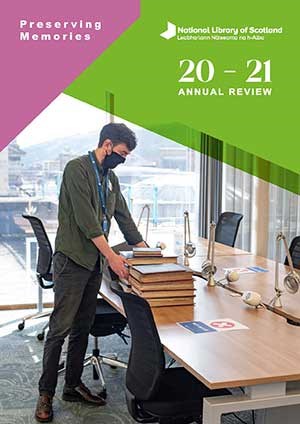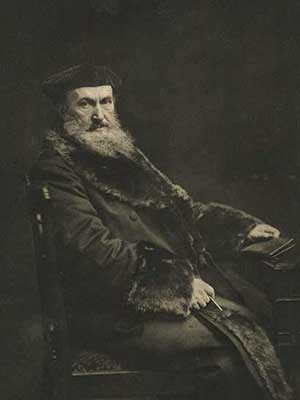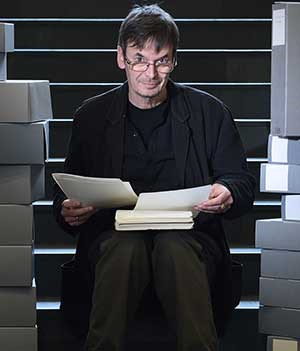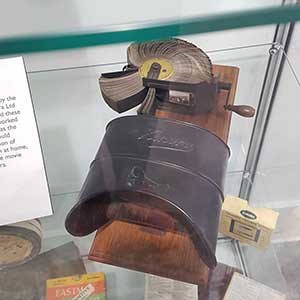On this page
Welcome
Dr John Scally, National Librarian


When I was writing the introduction for last year's Annual Review — only several months into the global pandemic — I had no idea I would continue to be reflecting on the Library during lockdown a year later.
You can expect Covid-related stories and themes running throughout this document — how we continued working remotely and on-site on new and exciting projects; how we coped with new ways of working and tried to reach people every way we could; and how we're approaching the post-pandemic world with optimism.
This past year has been tough for a lot of people and no more so than for those at the start of their careers. So we hired paid interns across a range of subjects and disciplines. These young people did us proud. They carried out superb work and, despite the challenging circumstances of working remotely, they developed fantastic working relationships across the organisation. We learned as much from them as they did from us and you can read more about them in these pages.
We continued to serve researchers as best we could when we were closed and launched an enquiry service for readers to chat with librarians, which was well-received. We also continued to add digitised or 'born digital' material to our website for people to access remotely.
Another success over the past year was our series of virtual events, workshops and seminars. People tuned in from all over the world to talks by curators, in-conversation events with guest panellists and authors, family activities and storytelling, and workshops on how to get the most from the collections at home.
We also launched new online learning resources linked to the Curriculum for Excellence. These included a comprehensive resource on African American revolutionaries in the Atlantic world during the 19th century, as well as a resource dedicated to 'Sunset Song' — one of Scotland's most beloved novels, penned by Lewis Grassic Gibbon.
In a bid to support emerging writers, we invited them to creatively respond to the year 2020. We commissioned 10 writers, who developed hard-hitting and emotional works spanning poetry, playwrighting, prose and graphic novellas, all of which are available to read on our website.
Midway through this 2020-21 year, we launched our new strategy for 2020-2025, called 'Reaching People'. There's little room for nuance in this title, which was deliberate – reaching people is our main focus in the lead-up to our centenary in 2025.
This major anniversary prompted us to think carefully about what we should look like in 2025, our role in 21st-century society and how we can best respond to a changing society — embracing new trends in how people access information and culture — all while remaining true to our core mission as guardian of the published and recorded memory of Scotland.
We have seen this year how important it is that we are prepared for rapid change, which requires flexibility and creative thinking. Our response to the pandemic demonstrated an agility that will frame our thinking for some time to come.
Many of you will by now have learned that I am retiring from my role in October. It has been an immense pleasure and a great privilege to serve as National Librarian for these past seven years. I feel we have achieved a lot and grown as an organisation during that time.
Leaving the Library will be a wrench, but I will retire with great fondness for the Library, our superb staff, the people we serve and, last but not least, our donors, patrons and supporters who have helped us to carry out our work. My thanks to you all.
Safeguarding collections
Acquisitions
Photograph album of Dugald Christie, medical missionary in China
We acquired the photograph album of Dugald Christie, a Church of Scotland medical missionary to China. Christie, born in Glencoe in 1855, is perhaps best known as the founder of Mukden Medical College, in what is now Shenyang, in North-East China.
The album has 238 photographic prints, which capture Christie and his colleagues at work, including in the newly founded medical college.
There is considerable historical and social interest in the album, covering subjects including the Russo-Japanese War and the Manchurian plague. The pneumonic plague struck the area in 1910-1911 and Christie played a major role in helping to combat the illness.
This album is of particular relevance to our existing archives relating to Christie's career and to Mukden Medical College, including those in the Church of Scotland World Missions archive.
Archive of the Cameran Photographic Society of Edinburgh
We acquired the archive of the Cameran Photographic Society of Edinburgh at auction from Swann Galleries in New York. The archive includes three photograph albums, each organised chronologically and containing mounted prints.
The albums begin in 1894, and end in 1910. Alongside each print is a title and date, and the name of each of the amateur photographers, so there is scope to research the members and activities of the society. Women appear to be well represented among the membership.
The society ran an annual competition with a number of specific themes, which is reflected in the subject matter of the albums. There is added research value in the written records which accompany the albums. They include lists of members, lists of themes and rules for annual competitions, notes about photographic excursions taken by the Society, and a minute book, which begins in 1894 and runs until 1917.
The society was previously unknown to us, and this acquisition will offer researchers the opportunity to find out more about the practice of photography in Scotland during this period.
'Camera Work: a photographic quarterly', no. 8, October 1904, New York

The American periodical 'Camera Work', published from 1903 until 1917, was founded by the American photographer and art promoter Alfred Stieglitz (1864-1906). Stieglitz wanted to produce a completely independent magazine of pictorial photography which would be 'the best and most sumptuous of photographic publications'.
The issues had beautiful hand-pulled photogravures, critical writings on photography, aesthetics and art, and reviews and commentaries on photographers and exhibitions.
Stieglitz did much to promote Scottish photographer James Craig Annan (1864-1946) and his photogravures, and this issue reproduces some of Annan's work and praises him as one of the foremost photographers of his generation. Pictured right is the University of Glasgow's Professor John Young in ceremonial robes. Annan photographed him in 1901 shortly before his death and used the negative to create a photogravure, published in 'Camera Work' in 1904.
Duns Scotus
We bought a stray pocket volume of a text of the Scottish philosopher John Duns Scotus (died 1308). It contains the second part of his most influential work, the 'Commentary' on the four books of 'Sentences' of Peter Lombard, a 12th-century compendium of theology that was universally studied in Duns Scotus's time. The manuscript was written in 1568 in the Convent of San Francesco al Monte in Perugia, Italy.
The convent's library was plundered during the Napoleonic wars and the companion volumes of our small manuscript, probably three in number, are likely to be lost. The manuscript is in its original limp vellum binding with its title on a paper-covered spine. Two leather ties are now missing but holes in the binding and impressions on the fore-edge are still visible.
Letters and poem of Robert Burns
We acquired four letters and part of a poem written by Robert Burns at a Lyon and Turnbull auction. The four manuscripts are autograph letters from Burns to: Francis Grose, on sending him his poem 'Tam o' Shanter'; James Smith, on his feelings about Jean Armour prior to Burns's planned emigration to Jamaica; Thomas Sloan, on a recent interaction with Robert Riddell of Glenriddell; and David Staig, on writing poetry.
The poem is part of a sonnet written by Burns on the death of Riddell. The material on Riddell is especially relevant to our collections as the Glenriddell manuscripts of Robert Burns, held at the Library, constitute the largest single collection of Burns's manuscripts in existence. Several of these manuscripts have remained out of the public eye for decades. The letters and poem have been previously published, but in several instances these came from transcripts of the originals which have not been seen since J DeLancey Ferguson edited the letters of Burns in 1931.
The poem demonstrates evidence of Burns's poetic process and contains alterations and variants not found in published versions. We acquired these manuscripts with generous contributions from the Soutar Trust and the Friends of the National Libraries.
Alata castra Scotiae Regia urbs et Metrolis Vulgi Edimburgum, by Benjamin Wright, Amsterdam: Claes Janszoon Visscher, 1649
This small map of the south-eastern coastline of Scotland was originally engraved in 1599 by Benjamin Wright for inclusion in a proposed atlas to be published by Cornelis Claesz. Aimed at Dutch merchants, the atlas would depict the coastlines, firths and trading settlements.
This atlas was never published, but Claesz's apprentice, Claes Visscher, resurrected the idea 50 years later, using the original engraved plates, including this one, and adding more of his own. The resulting pocket atlas, 'Tabularum Geographicarum Contractarum', was published in 1649. There are three known examples, with only that at the British Library being complete.
The Holy Bible, containing the Old and New Testaments, Edinburgh, 1772
The Bible is bound in full green morocco leather decorated with gilt, in Rococo style by James Scott of Edinburgh. It is a beautiful binding with an interesting provenance.
This book was once part of a two-volume set with a similarly bound Book of Common Prayer. The latter volume is recorded in Loudon, 'James and William Scott bookbinders', item Js9 page 34 (owner unknown). It was part of the John Roland Abbey sale at Sotheby's on 21 June, 1965, lot 226.
Both our volume and the companion volume are inscribed 'S E Philips 1774' which, as suggested by Loudon, is probably the date of the binding.
Edinburgh Travel Book, by Floc'h, Louis Vuitton, 2020
We bought the deluxe, limited edition of Louis Vuitton's 'Edinburgh Travel Book' by French cartoonist and illustrator Jean-Claude Floch (Floc'h). Floc'h uses his 'ligne claire' style to capture the city of Edinburgh in exquisite fashion.
This new publication, signed by the artist, includes an original silkscreen painting printed on Vélin d'Arches paper by Atelier Silium. It is a limited edition of 30 copies.
The travel books are a series by Louis Vuitton that pairs an artist with an international destination (typically a city), resulting in a fascinating new lens through which to see each place. Floc'h's illustrations are very much in the style developed by 'Tin Tin' creator Hergé, giving the book an early to mid-20th-century mood.
It is not the only Louis Vuitton item we have in our collection. It will join two suitcases that belonged to mountaineer Fanny Bullock Workman.
In the news
Ian Rankin archive ready for exploration

Towards the end of 2020, we announced that the literary archive of the UK's biggest-selling crime novelist, Ian Rankin, was available to view at our reading rooms.
Mr Rankin donated his archive to the Library in 2019, and the subsequent cataloguing process resulted in 387 files or manuscripts that people can view at the reading rooms. This includes correspondence with literary figures such as Ruth Rendell, as well as publishing companies, production companies and charities. Not surprisingly, police officers feature regularly in correspondence.
Described by Mr Rankin as 'a pretty complete author's life, late 20th-century style', the archive material dates from 1972–2018. As well as donating the archive, Mr Rankin made a substantial donation towards the creation of a post to itemise and catalogue each item. The post was also made possible through generous donations from the W M Mann Foundation and the Gladys Krieble Delmas Foundation.
Oldest known moving images of Wick saved for posterity
Following years of detailed and specialised work, we completed the digitisation, re-animation and careful restoration of footage of Wick from the turn of the 20th century.
The Wick Society gave five Kinora reels to our Moving Image Archive about 20 years ago for protection and preservation. The Kinora was an early moving image device for which individual frames of film were printed on to small cards attached to a circular core. The reel of cards — like a large, round flip-book — was placed in a Kinora viewer and revolved by turning a handle.

Deemed to be the work of local photographer John G Humphrey (1868–1949), the 'Wick Kinora Reels' contain scenes and events that are estimated to have taken place between 1897 and 1910. The footage includes ships and tugboats arriving into Wick Harbour, fishermen 'redding' their nets, a storm in Wick Bay, and a church parade — likely marking Queen Victoria's Golden Jubilee in June 1897.
Together they provide a unique glimpse of a local industry just before the widespread adoption of mass industrial fishing. Developed by the Lumière brothers in 1895 (while they were simultaneously inventing the cinematograph), the Kinora was designed to allow people to enjoy short films at home.
A Kinora Viewer and the original Wick Kinora Reels remain at the Library's Moving Image Archive at Kelvin Hall in Glasgow. The films are available to view on the Moving Image Archive website.
Conservation and digitisation
Keeping collections safe
When lockdown began in March 2020, our conservation team's priority was to work out how many emergency response volunteers they would be able to call on in this period, if needed.
Our numbers were affected by self-isolation requirements and travel restrictions, so we put out a call for new volunteers among staff throughout the Library. We were overwhelmed by the positive response from colleagues and now have an active and engaged cohort of more than 30 volunteers available to be deployed in an emergency situation.
Thanks to our remote technology, we were able to analyse live environmental monitoring data across the Library's buildings, which helped us to identify any areas of concern.
This analysis and research helped inform our reopening plans and identify priority areas for collection surveys when we were able to return to the Library.
Just before the first lockdown was fully lifted, our conservators completed a visual check of all collection items in storage. This was to ensure no issues relating to mould or pest infestations had occurred during lockdown. They completed the survey over a period of two weeks, and found that no major damage had happened when we were closed.
This was the first time we conducted a survey of this scale. It provided a clear understanding of general conditions, which proved to be a timely exercise ahead of the appointment of Mel Houston ACR, our new Preventive Conservator.
New in digital publications
We have subscribed to Ethnic NewsWatch (a ProQuest eResource), an impressive asset that provides current full-text newspapers, magazines, and journals of the ethnic and minority press, providing researchers access to essential, often overlooked perspectives.
Our subscription also provides historical coverage of Native American, African American, and Hispanic American periodicals from 1959–1989. Together, these resources present an unmatched, comprehensive, full-text collection of more than 2.5 million articles from over 340 publications. Perhaps the most valuable aspect of the resources is the inclusion of unique community publications not found in any other database, as well as top scholarly journals on ethnicities and ethnic studies.
The historical file of 'Ethnic NewsWatch: A History' provides more than 300,000 articles from 1959–1989. This hard-to-find content provides primary source material across three turbulent decades — the civil rights struggle, Vietnam War protests, dramatic changes in immigration law, trickledown economics, and the status of migrant workers.
We have purchased digital publications from North America, Australasia and Europe on a broad range of subjects including poetry, politics, early modern studies, activism, antiquity, trade, and critical race theory. Reflecting the huge number of titles published this year, and over the past few years, on slavery, race and the Black diaspora, a particular focus has been on building our collections in these areas and on collecting the work of Black scholars, poets and novelists.
We also bought an extensive amount of e-books from university presses as well as from smaller independent publishers, allowing our readers remote access to a range of books with significant social and cultural import. The most used e-book we purchased in the past year is 'Writing Identity in Medieval and Early Modern Scotland', edited by Eva Von Contzen and L A J R Houwen.
Collecting Covid
Ephemera such as flyers and leaflets, as well as websites and public-facing social media pages, provide rich insight into what it was actually like for people and communities living through times such as those we experienced in 2020 and much of 2021.
As Scotland's national library, it was vital that we collected as broad a range of material as possible so that future researchers can get an in-depth account of what the Covid-19 pandemic has been like.
Collecting the printed evidence has proven to be especially difficult, because it was happening during lockdown at a time when our usual collecting practices were restricted. But we have been able to archive more than 4,000 web pages, many of which were changing daily, so that the rapidly emerging story of Scotland's response to the coronavirus was saved for the future.
As well as the targeted collecting of Scotland's experience of Covid-19, we also have an even bigger collection about the impact of the virus, as a consequence of something we call 'incidental Covid collecting'. As we're entitled to receive a copy of every publication from the UK and Ireland, we acquire thousands of items each week. When we returned to the shelves after the end of the first lockdown in 2020, we found that in a pile of about 30 different titles spanning magazines and journals, Covid was on the front cover or first page of every single one — everything from 'Copper Worldwide' to 'Ice Cream — the magazine of the Ice Cream Alliance'. It is further evidence that there wasn't a single part of our lives that the pandemic hadn't touched.
We encourage organisations to get in touch with us so they can contribute to Scotland's memory of this pandemic and of how it was managed.
Improving access
'One Third Digital' pledge progress
We remain on track to have a third of our collections in digital format by our centenary in 2025 — a pledge we made in 2015.
This year, we digitised more than 11,500 items from our collections, including maps of Scotland, chapbooks, antiquarian Scottish books, photographs from the MacKinnon Collection, photographs on nitrate film from the Workman Collection, mediaeval manuscripts, sound recordings (as part of the multi-year Unlocking our Sound Heritage project), film reels, and video tapes.
Following a special scanning project with a large-format flatbed scanner, we were thrilled to put online more than 5,000 fragile, folded and 'special collection' maps of Scotland over the past year.
These maps are very important for their content, including many manuscripts, as well as special states of early maps of Scotland.
The largest group includes more than 1,000 plans by the Stevenson firm of civil engineers (circa 1800s-1940s), showing harbour works in coastal towns, bridges, canals, railways, river engineering and lighthouses.
We also added more than 900 rural estate maps (circa 1770s-1920s), with particular concentrations on Sutherland, Lanarkshire and East Lothian.
Other additions include 450 new printed maps of Scotland, 430 town plans, 300 county maps, and 100 military maps.
A particular highlight has been to collaborate with the Writers to the Signet Society in putting their fine collection of Signet Library maps of Scotland online.
Library wins Wikimedia award
The Library won the 2020 Partnership of the Year Award from Wikimedia.
Its accolades recognise the work of community members and partner organisations in sharing open knowledge with Wikimedia.
Wikimedia is the collective name for the Wikimedia movement, which revolves around a group of inter-connected projects, including Wikipedia, Wiktionary, Wikiquote and others. Wikimedia aims to use the collaborative power of the internet, and the wiki concept, to create and share free knowledge of all kinds.
As the Covid-19 situation progressed, about 70 Library staff who were by then working from home took part in a project to upload and transcribe chapbooks from the collections, to Wikicommons or Wikisource. This resulted in what is described on Wikimedia as 'possibly the largest ever partner staff group engaging with Wikimedia'.
The project resulted in more than 2,000 pamphlets being transcribed. We plan to re-import these items into the national collections.
Intake and cataloguing
We took in more than 2.25 million items over the course of the year.
Intake of books and other physical publications took a major hit due to the pandemic. Lockdowns created major backlogs and this, of course, also affected publishers' distribution. We also paused the delivery of donated material. This resulted in a drop of around 50 per cent from the previous year.
In contrast, it was a particularly good year for acquiring digital content, and we took in more than two million items, which included 960,000 public petitions — growth of more than 40 per cent on the previous year.
To provide access to these materials, we created more than 58,000 bibliographic records and more than one million records were imported to support access to non-print legal deposit content (material that comes to us in electronic format). As well as this, we upgraded more than three million records to improve access and ease of discovery.
Hidden collections
Despite the restrictions over the past 18 months, we continued work on the Hidden Collections programme.
We catalogued more than 407,000 items, making almost 52.09 per cent of the 'hidden' collections (collections that are at the Library but have yet to be catalogued) publicly available. Highlights from the year include the completion of the Music Retro-Conversion Project, completion of a collection of Scottish Government and Scottish Parliament digital publications, and the global import of more than 42,000 records from the 18th century House of Lords collection.
Music Retro-Conversion Project
We have been moving our music card catalogues online, making the searching process faster and easier to use.
Over the past two centuries, a multitude of catalogues and other manual finding aids have been compiled following ever-changing cataloguing rules. So the music 'retroconversion' project was a mammoth one because 340,000 catalogue cards were involved.
The work was done in three main phases. First, the existing catalogues and finding aids, right, were converted into digital form. After digitisation, the data on the cards was converted to readable text. The third and last phase of the project involves editing and checking the data before preparing it to be inputted into our online search facility, Library Search.
Due to be completed later this year, the project will be of real benefit to people who can then find out what music the Library holds from home. More detailed information about the project can be found on the Library blog.
Gaelic Arts access and rights clearances
We recently completed work vital to opening up access to our Gaelic collections. We hold thousands of music, drama, educational and literary publications by An Comunn Gàidhealach, the standard-bearer of Gaelic traditional culture for more than a century. Yet because much of this material is within copyright, we have been unable to share this rich resource as widely as we would like. Musical works, in particular, have to be played, performed and enjoyed to keep the pieces alive, and so we established the Gaelic Arts Access Project to open up the collection.
Some sleuthing was required. The writers, composers, translators and arrangers of approximately 4,000 works had to be identified, and tracked down, not only to ask for permission to publish their work online and for creative reuse, but also to gather some of the stories behind these pieces from those who created them.
To our surprise and delight, everyone contacted granted permission and so soon this trove of creative Gaelic output will be available online for anyone to use and enjoy. Kindly supported by Bòrd na Gàidhlig and the Music Libraries Trust.
